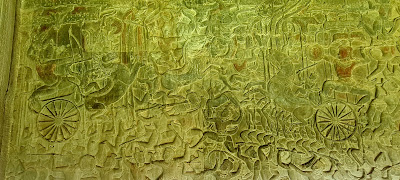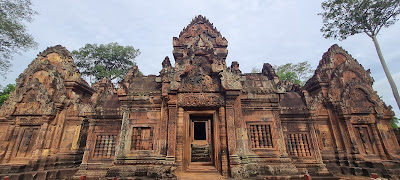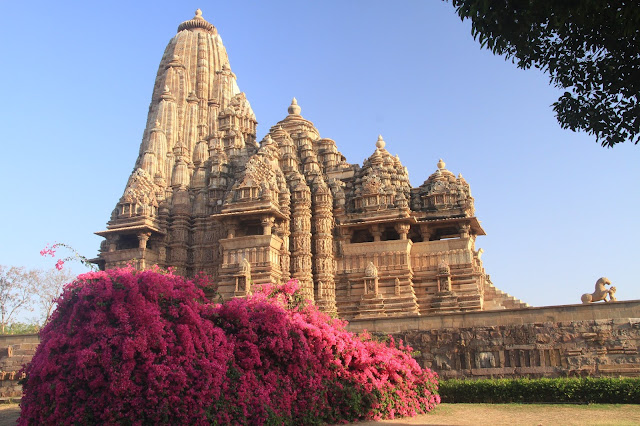Green. The first thing that strikes me as I return to North-East India is the greenery that abounds. As you progress towards Upper Assam from Guwahati through tea gardens, the shades of greenery deepen. Today, we are on a 262 kms drive from Guwahati to Bhalukpong, a busy town at the border of Assam and Arunachal Pradesh. Crossing the 3 km length of Kolia Bhomora Setu over Brahmaputra near Tezpur, named after an 18th century Ahom General, is a high point of this drive. We are headed for a vacation at India’s `Land of the Rising Sun’, albeit in the western-most part of the state.
********
Liquor
outlets of all sizes proliferate Arunachal Pradesh. Its not difficult to
discern why. A 750 ml variant of Old Monk is offered at INR 280, exactly half
of what you would expect to shell out in your city. The tiniest of outlets
stock the most esoteric single malts from Scotland. For me, however, the
attraction of these shops lies in the availability of local wine, which are
produced at Dirang. They come in four fruit variants. Peach, kiwi, apple and
persimmon. Each more enticing than the other. An upstream consequence of the
wine industry in Arunachal is the increased acreage of such fruit cultivation
in the hills. I am no oenophile. But I have not consumed as much wine in the
rest of my life as I did on this trip. I am unable to fathom why these wines
are not available elsewhere.
********
For travelers
between Guwahati and Tawang, the quaint town of Dirang is a preferred stopover.
This place has historical significance. This was where an Indian envoy
officially received the Dalai Lama when he escaped from Tibet in 1959.
I shall avoid
the touristy `things to do and places to visit’ stuff about Dirang. But there
are some features that I need to highlight. The nearby areas of Mandala Top and
Sangti Valley are major attractions for bird lovers. Sangti Valley is the
winter nesting grounds for the endangered black-necked crane, that migrate from
upper reaches during winters. The arrival of these cranes are considered
auspicious among local Monpa community and Buddhists.
One `must visit’ site at Dirang should be Thupsung Dhargye Ling which, in Tibetan,
means `Place of Flourishing of Buddha’s Speech’. This monastery cum learning
centre was consecrated by the Dalai Lama in 2017 to further Tibetan and
Buddhist studies. Perched atop a hillock within the town, it offers ethereal
views of the surrounding valley and hills.
********
China has a Voldemort effect in these parts. For many
years after the war of 1962, the roads in Arunachal were kept in disrepair.
This was perhaps based on a thinking by the powers that be that if a repeat
incursion by China occurred, their progress into India would be hampered by
poor road conditions.
In recent times, New Delhi has done a volte-face. Consolidation of Indian defence forces in this region has necessitated upgrading of road infrastructure for their movements. Border Roads Organisation (BRO) continues their yeomen’s work for construction and upkeep of roads in challenging terrain. Their latest engineering marvel is the all-weather Sela Tunnel, inaugurated in 2024, that provides round-the-year connectivity between Guwahati and Tawang. It bypasses the treacherous Sela Pass at a height of 13,700 ft, prone to frequent landslides and snowfall. What interests me about BRO is their effort in putting up quirky signs at every other turn on the roads.
********
More on engineering marvel, from another time. About 24 kms before you hit Tawang lies the Chakzam Bridge. In Monpo language `chak' means iron and `zam' means bridge. In times gone by, this 700 year old iron bridge connected the present Mogto area with Tawang. Lama Chakzam Wangpo, a revered monk, built this iron suspension bridge. It faced and survived severe shelling from the Chinese army in 1962.
********
For complex historical reasons, China maintains its claims to have control of the area around Tawang. They refer to this area as South Tibet and cite the historical ties between Tibetan Buddhist monasteries in Tawang and Lhasa as evidence, arguing that these cultural and religious connections justify their claim. The second largest monastery in the world, after Lhasa, is at Tawang. The Dalai Lama’s last visit to Tawang was in 2017. China throws hissy fits each time the Dalai Lama expresses his wish to return to Tawang.
********
A separate
permit from the Indian army, over and above an Inner Line Permit for Indians,
is required to visit Chumi Gyatse (Holy Water) Falls. It is located near the
Line of Actual Control (LAC) with China. It is a stunning spectacle of 108
waterfalls flowing down steep cliffs at an elevation of 11,500 ft, creating an
image of a massive curtain of water. Local belief among Monpa Buddhists suggests
that Chumi Gyatse was created by Guru Padmasambhava (who introduced Buddhism to
the region thirteen centuries ago) when he hurled his rosary of 108 beads on
the hills. There is huge faith among locals, as well as the Indian army
personnel, about the curative / therapeutic properties of the water from the
Falls. Given the sensitivity of the area, personnel of the Bihar Regiment who
man the posts here ensure that mobiles and cameras are handed over in their
custody before commencing the visit. Only one person in a visiting group is
allowed access to a mobile phone to click photos at specified spots. You are
also instructed to put your phone on `flight’ mode, lest the phone latches on
to tower signals from China. I get into a conversation with a jawan from the
regiment. He overheard me talking in Bengali. He is from Kharagpur. He wants to
ensure that he remains conversant in his mother tongue, having been stationed
here for two years.
********
Our overnight
stopover on the return drive was at an elevation of 7664 ft at Shergaon. Eaglenest
Sanctuary is a two-hour drive from this village. If your key words search on
your AI tool for a vacation include `tranquility, bird sounds, stunning 360
degree views of green hills, feet-up-in-the-air, nothingness’ etc., Shergaon
may not appear as an option. But on all these parameters, I’d rank Shergaon at
the top. Its a pity we could not extend our stay here. But as Arnold
Schwarzenegger growled in The Terminator, `I’ll be back’.
********






















































